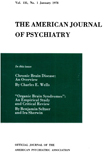OBSERVATIONS ON THE NATURAL HISTORY OF HYSTERIA
Abstract
This study, based upon a 6- to 8-year follow-up of 25 patients, who were diagnosed as suffering from hysteria originally, and again at follow-up, resulted in the following conclusions: 1. Hysteria, as here defined, is a distinct, recognizable syndrome which is very similar in its clinical features from patient to patient; 2. Hysteria is a chronic illness which lasts many years and which is nearly always free from significant remissions; 3. Hysteria is a multisymptomatic syndrome which can and should be distinguished from conversion reactions, which are individual symptoms found in many disorders in addition to hysteria.
Access content
To read the fulltext, please use one of the options below to sign in or purchase access.- Personal login
- Institutional Login
- Sign in via OpenAthens
- Register for access
-
Please login/register if you wish to pair your device and check access availability.
Not a subscriber?
PsychiatryOnline subscription options offer access to the DSM-5 library, books, journals, CME, and patient resources. This all-in-one virtual library provides psychiatrists and mental health professionals with key resources for diagnosis, treatment, research, and professional development.
Need more help? PsychiatryOnline Customer Service may be reached by emailing [email protected] or by calling 800-368-5777 (in the U.S.) or 703-907-7322 (outside the U.S.).



